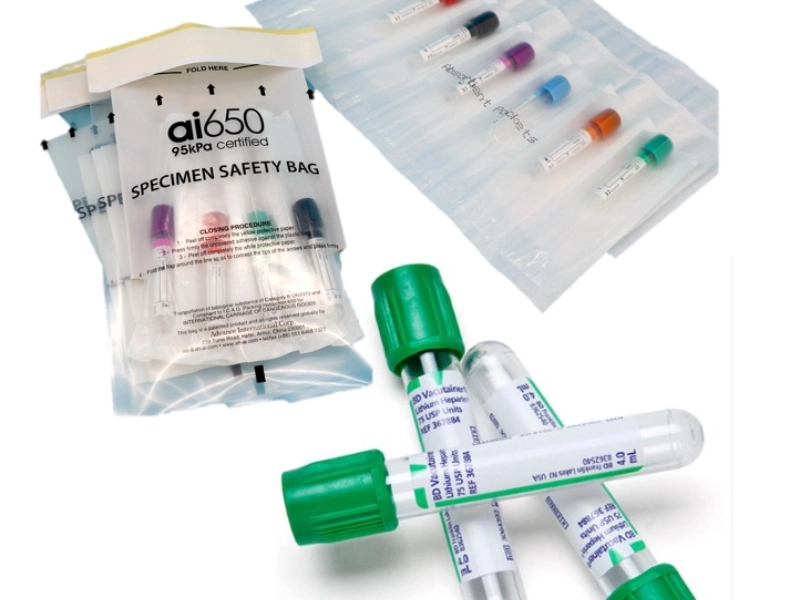Lab Sample Collection Bags Enhance Specimen Transportation Safety and Efficiency
Release time: 2025-08-05
In the fast-paced world of laboratory medicine, the safe and efficient transportation of biological specimens—such as blood, urine, and tissue—is critical to accurate diagnostics and research. Lab sample collection bags, commonly referred to as specimen bags, are indispensable tools in this process. These specialized bags are designed to securely collect, store, and transport samples while maintaining their integrity and ensuring handler safety. Recent advancements in specimen bag design, coupled with emerging transportation technologies, are addressing longstanding challenges and improving the efficiency of specimen transportation in healthcare and research settings.
The Role of Lab Sample Collection Bags
Lab sample collection bags serve as the primary containment for biological samples, ensuring they remain uncontaminated and secure during transportation. Typically made from durable materials like 2 mil thick polyethylene, these bags are built to withstand the rigors of transport while preventing leaks and spills. Key features include:
- Biohazard Symbols: Clearly marked to alert handlers to the sensitive nature of the contents.
- Leak-Proof Seals: Adhesive or zipper closures ensure samples remain contained, meeting Department of Transportation (DOT) and International Air Transport Association (IATA) regulations for infectious substances.
- Dual-Pouch Design: A separate compartment for requisition slips keeps paperwork isolated from samples, improving organization and reducing contamination risks.
These features make specimen bags essential for maintaining the chain of custody in hospitals, clinics, and laboratories, ensuring samples arrive in optimal condition for testing.
Addressing Safety Challenges
Improper packaging has been a persistent issue in specimen transportation. For example, a 2024 report from the CDC highlighted instances where specimens, such as nasal swabs, were transported in inadequate containers like grocery bags, leading to potential contamination and safety risks. Such practices underscore the need for reliable specimen bags. Modern lab sample collection bags address these challenges by offering robust construction and tamper-evident seals, reducing the risk of spills and ensuring compliance with safety standards.
Recent Innovations in Specimen Bag Design
Recent developments in specimen bag design are transforming laboratory workflows. A notable advancement, reported on May 5, 2025, involves the introduction of custom, easy-to-open, color-coded specimen transport bags. These bags offer several benefits:
- Color-Coding: Allows quick identification of sample types or urgency (e.g., red-tinted STAT bags for immediate attention), streamlining processing and reducing errors.
- Easy-Open Features: Reduces physical strain on laboratory staff, addressing occupational hazards like wrist injuries caused by repetitive handling of traditional bags.
- Cost and Time Savings: Enhances efficiency by minimizing processing delays, leading to significant cost reductions for healthcare facilities.
These innovations reflect a growing emphasis on user-friendly designs that prioritize both safety and operational efficiency.
Market Growth and Demand
The specimen transport bag market is experiencing robust growth, with projections estimating a 13.2% annual growth rate from 2025 to 2032. The market size, valued at approximately USD 200 million in 2024, is expected to reach USD 350 million by 2033. This growth is driven by:
- Increasing Demand: Rising volumes of diagnostic testing and research activities require reliable specimen transportation solutions.
- Regulatory Compliance: Stricter regulations, such as those from the DOT, necessitate high-quality bags that meet safety standards.
- Technological Advancements: Innovations in bag design and materials are fueling market expansion.
This growth indicates a strong future for lab sample collection bags, with ongoing investments in research and development likely to yield further improvements.
Supporting Technologies
Technological advancements are complementing the evolution of specimen bags. Pneumatic tube systems (PTS), increasingly adopted in healthcare facilities, offer rapid and secure transport of specimens within hospitals. According to a January 2024 report, PTS reduces transport times, minimizes handling errors, and lowers the risk of sample degradation. When used with high-quality specimen bags, these systems enhance the overall reliability of specimen transportation. Other technologies, such as specialized transport coolers and locking lab sample boxes, further support the safe movement of samples, particularly for temperature-sensitive or biohazardous materials.
Regulatory and Safety Considerations
Specimen transportation is subject to stringent regulations to ensure safety and accuracy. The DOT and IATA set guidelines for packaging and transporting infectious substances, requiring leak-proof containers and proper labeling. Lab sample collection bags are designed to meet these standards, with features like liquid-tight adhesive closures and standardized transport tubes. Compliance with these regulations is critical for laboratories acting as “shippers” when sending specimens to reference facilities, as outlined by Warde Medical Laboratory in 2020.
Challenges and Future Directions
Despite advancements, challenges remain in specimen transportation. Issues such as lack of communication between submitting and receiving laboratories and inadequate coordination can lead to delays or errors. The CDC’s 2024 report emphasized the need for improved coordination and standardized packaging protocols. Future developments may focus on:
- Smart Packaging: Incorporating sensors or tracking technology into specimen bags to monitor sample conditions during transport.
- Sustainable Materials: Developing eco-friendly bags to align with sustainable healthcare practices.
- Integration with Automation: Enhancing compatibility with automated laboratory systems to further streamline workflows.


